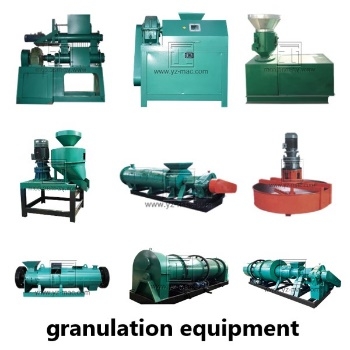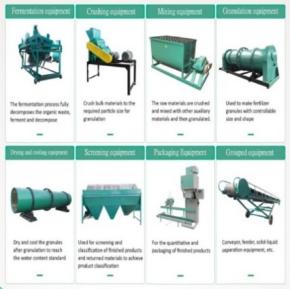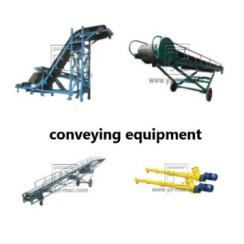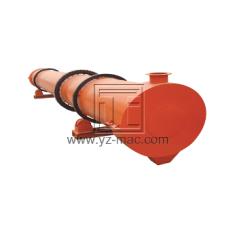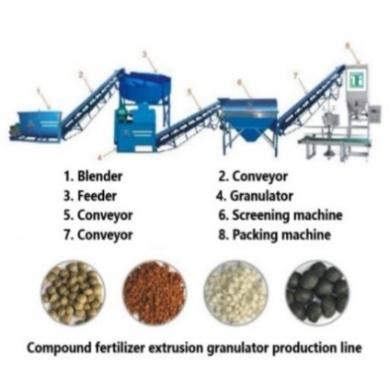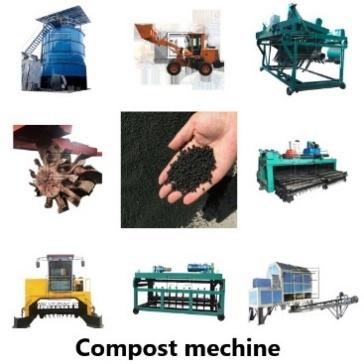Fertilizer granulation process
The fertilizer granulation process is a crucial step in the production of high-quality fertilizers. It involves transforming raw materials into granules that are easier to handle, store, and apply. Granulated fertilizers offer numerous benefits, including improved nutrient distribution, reduced nutrient loss, and enhanced crop uptake.
Stage 1: Raw Material Preparation
The first stage of the fertilizer granulation process involves preparing the raw materials. This includes sourcing and selecting the appropriate materials based on the desired nutrient composition and physical properties. Common raw materials for fertilizers include nitrogen sources (such as urea or ammonium nitrate), phosphorus sources (such as phosphate rock or phosphoric acid), and potassium sources (such as potassium chloride or potassium sulfate). Other micronutrients and additives may also be included in the formulation.
Stage 2: Mixing and Blending
Once the raw materials are selected, they undergo a mixing and blending process. This ensures a homogenous distribution of nutrients throughout the fertilizer mixture. Mixing can be done using various equipment such as rotary drum mixers, paddle mixers, or horizontal mixers. The goal is to achieve a consistent blend that provides a balanced nutrient profile for optimal plant nutrition.
Stage 3: Granulation
The granulation stage is where the mixed fertilizer materials are transformed into granules. There are different granulation techniques available, including:
Drum Granulation: In this method, the fertilizer mixture is fed into a rotating drum granulator. As the drum rotates, the material adheres to the surface and forms granules through a combination of rolling, agglomeration, and size enlargement. The granules are then dried to remove excess moisture and improve stability.
Extrusion Granulation: Extrusion granulation involves forcing the fertilizer mixture through an extruder, which contains a die with specific hole sizes and shapes. The pressure and shear forces cause the material to form cylindrical or spherical granules as it is extruded through the die. The granules are subsequently dried to achieve the desired moisture content.
Spray Granulation: In spray granulation, the liquid components of the fertilizer mixture, such as a solution of urea or phosphoric acid, are atomized into fine droplets. These droplets are then sprayed into a drying chamber where they solidify into granules through evaporation of the liquid. The resulting granules are dried further to reach the desired moisture level.
Stage 4: Drying and Cooling
After the granulation process, the newly formed granules are typically dried and cooled to improve their stability and prevent caking. This is done using specialized drying and cooling equipment such as rotary dryers or fluidized bed coolers. The drying process removes excess moisture, while the cooling process reduces the temperature of the granules before packaging or further processing.
Advantages of Granulated Fertilizers:
Controlled Release of Nutrients: Granulated fertilizers can be designed to release nutrients gradually, providing a sustained nutrient supply to plants over an extended period. This promotes efficient nutrient uptake and reduces the risk of nutrient leaching or runoff.
Uniform Nutrient Distribution: The granulation process ensures that nutrients are evenly distributed within each granule. This allows for consistent nutrient availability and uptake by plants, resulting in uniform crop growth and improved yield.
Enhanced Handling and Application: Granulated fertilizers have improved physical properties, such as increased density and reduced dustiness. These characteristics make them easier to handle, transport, and apply using spreading equipment, leading to more precise and efficient fertilizer application.
Reduced Nutrient Loss: Granulated fertilizers have lower solubility compared to powdered or crystalline fertilizers. This reduces the risk of nutrient loss through leaching or volatilization, ensuring that a higher proportion of applied nutrients is available to plants.
The fertilizer granulation process plays a vital role in transforming raw materials into high-quality granulated fertilizers. Through stages such as raw material preparation, mixing and blending, granulation, and drying and cooling, the process creates uniform, controlled-release granules with enhanced nutrient distribution and improved handling properties. Granulated fertilizers offer benefits such as controlled nutrient release, uniform nutrient distribution, ease of handling, and reduced nutrient loss.


